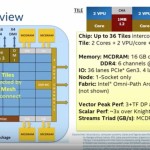“Memory bandwidth to the CPUs has always been important. There were typically CPU cores that would wait for the data (if not in cache) from main memory. However, with the advanced capabilities of the Intel Xeon Phi processor, there are new concepts to understand and take advantage of.”
Intel Xeon Phi Cluster Mode Programming (and interactions with memory modes) in a Nutshell
In previous articles (1 and 2) here on insideHPC, James Reinders described “Intel Xeon Phi processor Programming in a Nutshell” for Intel’s 72-core processor. In this special guest feature, he discusses cluster modes and the interaction of the memory modes with these cluster modes.
Intel Xeon Phi Memory Mode Programming (MCDRAM) in a Nutshell
James Reinders discusses one of the “mode” options that Intel Xeon Phi processors have to offer: memory modes. “For programmers, this is the key option to really study because it may inspire programming changes.”
Intel Xeon Phi Processor: A Look at the Basic Architecture
“Designing a new generation of hardware with such high performance needs to make sure that developers understand the basics, and are familiar with the architecture of a new system. Single thread performance with the Intel Xeon Phi processor is significantly better than previous designs. In addition, in order to speed up performance even more, vector processing, where applicable is critical in application performance. With two vector processing units (VPUs) per core, applications can execute two 512-bit vector multiply-add instructions per cycle. Each of these cores can deliver 32 double precision operations per clock cycle. The VPU executes all of the floating point operations as well as legacy instructions from SSE to AVX to the new AVX-512 instructions.”
Video: MCDRAM (High Bandwidth Memory) on Knights Landing
“The Intel’s next generation Xeon Phi processor family x200 product (code-name Knights Landing) brings in new memory technology, a high bandwidth on package memory called Multi-Channel DRAM (MCDRAM) in addition to the traditional DDR4. MCDRAM is a high bandwidth (~4x more than DDR4), low capacity (up to 16GB) memory, packaged with the Knights Landing Silicon. MCDRAM can be configured as a third level cache (memory side cache) or as a distinct NUMA node (allocatable memory) or somewhere in between. With the different memory modes by which the system can be booted, it becomes very challenging from a software perspective to understand the best mode suitable for an application.”







